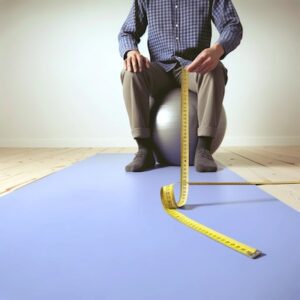How to Select Your Ideal Exercise Ball Size

Why Choose the Right Exercise Ball Size?
Choosing the correct exercise ball size is vital for enhancing your workouts and maintaining good posture. It prevents lower back injuries and improves overall comfort. Whether you’re using it for exercise or as a posture-enhancing seat, finding the perfect fit can make a significant difference. Let’s discuss how you can choose the best exercise ball size, understand their benefits, and what to do if you need professional advice.
How to Select the Ideal Exercise Ball Size
To find your perfect exercise ball size, consider your height, leg length, and the ball’s purpose. If you’re using the ball as a seat, ensure your hips sit higher than your knees to support the natural curve of your lower back. This position is crucial for preventing discomfort or injury during prolonged periods of sitting. Measure your height and refer to the manufacturer’s recommendations. Exercise balls typically range from 45 cm to 85 cm in diameter. For instance, individuals between 137 cm and 152 cm (4’6″ and 5’0″) should opt for a 45 cm ball, while those between 175 cm and 188 cm (5’9″ and 6’2″) would benefit from a 65 cm ball.
Who Should Use an Exercise Ball?
Exercise balls are versatile tools suitable for everyone, from athletes to office workers. They improve posture, core strength, and flexibility. They are also excellent for rehabilitation exercises, engaging multiple muscle groups simultaneously. If unsure about the right exercise ball size or if you have existing back issues, consulting a physiotherapist can provide tailored advice.
Where to Use an Exercise Ball
Exercise balls can be used at home, in the gym, or even at the office as an alternative to a chair. Their portability and versatility make them a great addition to any workout routine or ergonomic setup.
When to Use an Exercise Ball
Incorporate an exercise ball into your daily routine to improve posture and core strength. Use it during workouts or as a chair while working. Regular use can lead to significant health benefits.
What to Do If You Need Professional Advice
If you’re unsure about the right exercise ball size or have existing back issues, consult a physiotherapist. A professional can assess your specific needs and recommend the best approach to using an exercise ball effectively and safely.
Conclusion
Choosing the right exercise ball size is essential for comfort, safety, and effectiveness. By considering your height, leg length, and intended use, you can find the perfect fit for your needs. When in doubt, seek the advice of a physiotherapist to ensure you’re making the best choice for your health and wellness.
What to Do?
To get professional advice on choosing and using an exercise ball, consult your physiotherapist. They can provide tailored recommendations based on your needs and help you incorporate the exercise ball into your routine safely.
Recommended Exercise Ball Size
| Exercise ball diameter | Person’s height |
| 45 cm | 5′ and under |
| 55 cm | 5’1″– 5’8″ |
| 65 cm | 5’9″– 6’2″ |
| 75 cm | 6’3″– 6’7″ |
| 85 cm | 6’8″ and taller |
Ball Chair Size
To determine the minimum height for your ball chair, measure from the top of your kneecap to the ground while seated. Add a few centimetres to accommodate the height of your shoe heels. Remember that a ball will compress slightly under weight if it’s not fully inflated, so an oversized, softer ball might make you sit too low. Ideally, when seated, your thighs should slope downwards from your hips to your knees.

Exercise Ball Size FAQs
1. What size exercise ball should I use for my height? Measure your height and refer to a size chart. Typically, a person between 5’1″ and 5’8″ would use a 55 cm ball.
2. Can using an exercise ball help with lower back pain? Yes, using an exercise ball can improve posture and strengthen core muscles, which can alleviate lower back pain.
3. How do I know if my exercise ball is the correct size? When seated, your hips should be slightly higher than your knees. This ensures proper posture and comfort.
4. What are the benefits of using an exercise ball? Exercise balls enhance core strength, improve posture, increase flexibility, and can be used for a variety of workouts and rehabilitation exercises.
5. Should I consult a physiotherapist before using an exercise ball? If you have existing back issues or are unsure about the correct size and use, consulting a physiotherapist is recommended for tailored advice.
6. How do I inflate an exercise ball to the right size? Follow the manufacturer’s instructions and inflate the ball until it feels firm but still has some give when you sit on it. Measure its diameter to ensure it’s the correct size.
These recommendations and FAQ will help readers make informed decisions about using exercise balls effectively and safely.
Rochedale - Call 38410277
Book Online: RochedaleSalisbury - Call 32751044
Book Online: SalisburySandgate - Call 32691122
Book Online: SandgateRelated Articles
- Exercise Balls: Enhance Core Strength & Alleviate Back Pain – This article explains the benefits of using exercise balls for enhancing core strength and alleviating back pain, emphasising the importance of correct usage and professional guidance.
- How to Incorporate an Exercise Ball as Your Chair? – Provides insights on using an exercise ball as a chair to improve posture and reduce the risk of lower back pain, including tips for achieving the correct alignment.
- Balance Improvement – Discusses exercises and products for improving balance and stability, which can complement the use of exercise balls for a holistic approach to fitness and health.
- Effective Back Pain Exercise Routines For Pain Relief Guide – Although not directly linked, this article likely offers exercises and routines specifically designed for back pain relief, which can be beneficial for users of exercise balls focusing on alleviating back pain.
- Effective Back Exercises And Core Strength: Physio Insights – Likely provides deeper insights into back exercises and core strengthening, crucial for users interested in using exercise balls for these purposes.
- What are the Benefits for Using a Ball Chair at Work? – A comprehensive guide to ball chairs.
- Lower Back Pain – This page explains common causes and treatments for lower back pain, which can be alleviated by using an exercise ball correctly.
- Core Stability Exercises – Discover exercises that improve core strength, often recommended with the use of an exercise ball.
- Postural Exercises – Learn exercises to enhance posture, many of which incorporate exercise balls.
- Ergonomics and Workstation Setup – This page discusses how to set up an ergonomic workspace, including the use of exercise balls as chairs.
- Physiotherapy for Back Pain – Understand how physiotherapy can help manage and reduce back pain.
- Benefits of Using an Exercise Ball – Understand how exercise balls can improve your posture and core strength.
- How to Use an Exercise Ball – Get practical tips on incorporating an exercise ball into your daily routine.
- Exercises with an Exercise Ball – Explore various exercises you can perform with an exercise ball to enhance your workout.












